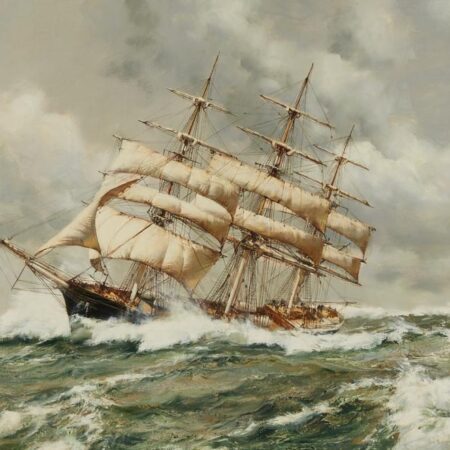
Montague Dawson
British Artist
1890-1973
Interested in selling a piece by Montague Dawson?
We have received top dollar for Montague Dawson works. Auction is the best way to quickly and transparently get maximum dollar for your artwork.

Montague Dawson (1890-1973), Stormy Weather/The Scottish Chief, available in Important Modern, Post-War, and Contemporary Art, March 25, 2020, 4 PM CST.
About Montague Dawson
A ship lists on stormy seas. On board, sailors scramble around, frantically keeping things in order. Above them, menacing gray clouds gather, and the sails billow out in the stormy gale. Step closer to the painting and it becomes clear that the movement is not just in the scene, but in the painting itself, visible in the sweeping textured brushstrokes that create the choppiness of the turgid gray-green waves and the violent spray of the crests, frantically boiling in all directions with the turbulent, stormy clouds. It is hard, when looking at Montague Dawson’s gripping depiction of a storm at sea, not to feel like you are there for a moment, hearing the sails snap in the wind, feeling the tossing of the ship and the cold spray of salt water on your face.
Dawson, who had been a sailor, was familiar with these sensations, bringing realism and intensity into an often staid genre. Dawson was born in 1890 into a family of artists, with his grandfather and uncle both being well-known marine and landscape painters. He received no formal training, but created art constantly through his childhood, often being inspired by scenes he witnessed on the harbor of Southampton Water, the south England town where he grew up. By 1910, Dawson was working as a commercial artist. When World War I broke out, Dawson enlisted in the Royal Navy, experiencing firsthand the realities of life on the high seas. By the end of the war, he was putting his painting skills to good use, working on dazzle camouflage on British battleships, which was used to disorient U-Boat gunners. He also painted scenes of the war at sea based on what he had witnessed. These were often featured in magazines, and an entire issue of The Sphere magazine was devoted to his illustrations of the German fleet’s surrender in 1918. Following the war, Dawson found success as a marine painter. He continued to paint from life as he had in the war, even serving as the official expedition artist for a voyage to the South Seas; however, he primarily focused on painting historical pieces.
These historical paintings, of which Stormy Weather/the Scottish Chief is one, were meticulously researched. Dawson made an effort to have every detail correct, ensuring that accuracy was blended with drama from Dawson’s memories of a life at sea. The Scottish Chief was a real ship, in service from 1856 to 1869, carrying cargo between England, India, Yemen, and Australia. In its years of service, the ship docked in far away places and experienced all aspects of seafaring trade, certainly including intense storms such as the one depicted. By mixing crisp historical detail and an engaging sense of movement, Dawson provides an accurate yet compelling snapshot of a moment in the golden age of sailing ship trading.
Please contact Revere Auctions if you have a work by Montague Dawson you are interested in selling or having appraised.
Get in touch for a free auction estimate.
